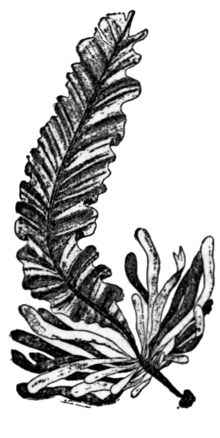Alaria esculenta
| Dabberlocks | |
|---|---|
 | |
| Scientific classification | |
| Domain: | Eukaryota |
| (unranked): | SAR |
| Superphylum: | Heterokonta |
| Class: | Phaeophyceae |
| Order: | Laminariales |
| Family: | Alariaceae |
| Genus: | Alaria |
| Species: | A. esculenta |
| Binomial name | |
| Alaria esculenta (Linnaeus) Greville | |
Alaria esculenta is an edible seaweed, also known as dabberlocks or badderlocks, or winged kelp. It is a traditional food along the coasts of the far north Atlantic Ocean. It may be eaten fresh or cooked in Greenland, Iceland, Scotland and Ireland. It is the only one of twelve species of Alaria to occur in both Ireland and in Great Britain.
Description
Grows to a maximum length of 2 m. The whole frond is brown and consists of a distinct midrib with wavy membranous lamina up to 7 cm wide on either side. The frond is unbranched[1] and tapers towards the end. The base has a short stipe arising from a rhizoidal holdfast. The stipe may bear several sporophylls which are club-shaped and up to 20 cm long and 5 cm broad which bear the spores.
It grows from a short cylindrical stipe attached to the rocks by a holdfast of branching root-like rhizoids and grows to about 20 cm long. The stipe is continued into the frond forming a long conspicuous midrib, all other large and unbranched brown algae to be found in the British Isles are without a mid-rib. The lamina is thin, membranous with a wavy margin.[2][3]
Distribution and ecology
Alaria esculenta is well known in Ireland, where it is known as Láir or Láracha, and in the rest of the British Isles[4] save the south and east of England. It is perennial.[5]
It is a common large algae on shores where there is severe wave exposure[6] attached to rocks just below low-watermark in the "Laminaria belt", and is common on rocky shores in exposed places.[7][8] It has a fairly high intrinsic growth rate compared to other algae, 5.5% per day and a carrying capacity of about 2 kg wet weight per square meter. It may reach lengths of about 2.5 m. It overlaps to a small degree (+) in distribution with Fucus serratus and somewhat more with Laminaria digitata. It has low and high light limitation values of about 5 and 70 W per square meter respectively. Its distribution is also limited by salinity, wave exposure, temperature, desiccation and general stress. These, and other attributes of the algae are summarized in Lewis (1964) and Seip 1980.[9][10][11]
Leaf-like sporophylls develop from the stipe and produce zoospores.[2]
A. esculenta may produce phlorotannins and oxidized lipids as protective functions against high photosynthetically active and UV radiations.[12]
World distribution
Europe: Greenland, Iceland, Faroes, Norway, France, Helgoland, Netherlands. North America: Alaska, Labrador and Massachusetts.[4]
See also
References
- ↑ Dickinson, C.I. (1963). British Seaweeds. The Kew Series. Eyre & Spottiswoode
- 1 2 Newton, L. (1931). Handbook of the British Seaweeds. British Museum (Natural History), London.
- ↑ Basic information for Alaria esculenta, Marine Life Information Network (MarLIN), retrieved 1 October 2007.
- 1 2 Alaria esculenta (Linnaeus) Greville, AlgaeBase
- ↑ Fritsch, F.E. (1945). The Structure and Reproduction of the Algae. Vol. 2. Cambridge University Press, Cambridge.
- ↑ Hardy, G. and Guiry, M.D. (2003). A Check-list and Atlas of the Seaweeds of Britain and Ireland. British Phycological Society. ISBN 0-9527115-1-6
- ↑ Lewis, J.R. (1964). The Ecology of Rocky Shores. The English Universities Press Ltd.
- ↑ Phillips, R. 1987. Seashells and Seaweeds. Elm Tree Books, London. ISBN 0-241-12028-4
- ↑ J. R. Lewis (1964). The Ecology of Rocky Shores. English Universities Press, London.
- ↑ Seip,K.L.1980. A mathematical model of competition and colonization in a community of marine benthic algae. Ecological modelling 10:77-104
- ↑ Seip, K.L. Mathematical models of rocky shore ecosystems. In Jørgensen, SE and Mitch, WJ (Eds) Application of ecological modelling in environmental management, Part B, Chap 13, pp 341-433
- ↑ Phlorotannin Production and Lipid Oxidation as a Potential Protective Function Against High Photosynthetically Active and UV Radiation in Gametophytes of Alaria esculenta (Alariales, Phaeophyceae). Franciska S. Steinhoff, Martin Graeve, Krzysztof Bartoszek, Kai Bischof and Christian Wiencke, Photochemistry and Photobiology, January/February 2012, Volume 88, Issue 1, pages 46–57, doi:10.1111/j.1751-1097.2011.01004.x
Further reading
- Gordillo, Francisco J.L.; Aguilera, José; Wiencke, Christian (2015). "Ocean acidification modulates the response of two Arctic kelps to ultraviolet radiation". Journal of Plant Physiology. 173: 41–50. doi:10.1016/j.jplph.2014.09.008.
- M. Indergaard & J. Minsaas (1991). "Animal and Human Nutrition". In M. D. Guiry & G. Blunden. Seaweed Resources in Europe. pp. 21–64. ISBN 0-471-92947-6.
- Olischlaeger, Mark; Wiencke, Christian (July 2013). "Seasonal fertility and combined effects of temperature and UV-radiation on Alaria esculenta and Laminaria digitata (Phaeophyceae) from Spitsbergen". Polar Biology. 36 (7): 1019–1029. doi:10.1007/s00300-013-1325-5.
External links
- "Alaria or edible kelp (Alaria esculenta)". Grand Manan Island, New Brunswick. 2004-05-30. Archived from the original on 2005-05-18.
- M. D. Guiry & Wendy Guiry (2006-08-30). "Alaria esculenta (Linnaeus) Greville". AlgaeBase.